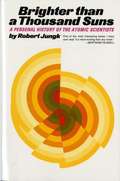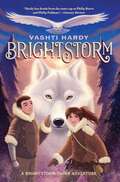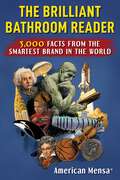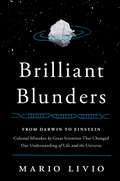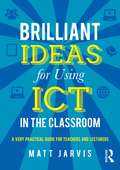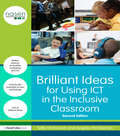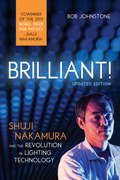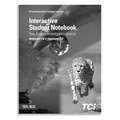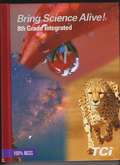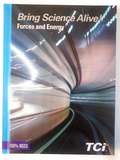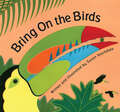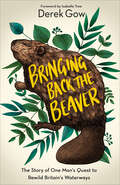- Table View
- List View
Brighter Than a Thousand Suns: A Personal History of the Atomic Scientists
by Robert Jungk James CleughAn account of the remarkable scientists who discovered that nuclear fission was possible and then became concerned about its implications. Index. Translated by James Cleugh.
Brightstorm: A Sky-ship Adventure (Brightstorm #1)
by Vashti HardyCritically acclaimed in the UK, Brightstorm is a fast-paced fantasy adventure novel that will set imaginations soaring. Arthur and Maudie Brightstorm receive devastating news: their famous explorer father has died in a failed attempt to reach South Polaris. To make matters worse, the Lontown Geographical Society finds Ernest Brightstorm guilty of sabotaging the expedition of his competitor, Eudora Vane. But a mysterious clue leads the twins to question the story they’ve been told—and to uncover the truth, they must undertake the journey of a lifetime. Joining the ragtag crew of a homemade sky-ship captained by the intrepid Harriet Culpepper, Arthur and Maudie race to South Polaris to salvage their family’s reputation and find out what really happened on their father’s doomed expedition. Brightstorm is a propulsive and compelling fantasy adventure set among the vibrant landscapes and dynamic characters of Vashti Hardy’s vividly imagined world.
Brilliant Bathroom Reader (Mensa®): 5,000 Facts from the Smartest Brand in the World
by American MensaAmerican Mensa presents: The Brilliant Bathroom Reader—The ultimate book of 5,000 facts curated by the world's smartest brand. Perfect to expand any curious mind! Whether gearing up for a big trivia night or simply wanting to give your brain something interesting to think about, this big book of 5,000 facts from the smartest brand in the world fits the bill. These facts will make you think. They&’ll make you wonder. You may even want to research more about some of these topics. Most of all, you&’ll have a ton of fun learning about everything from Thomas Edison&’s attempts at mind reading to Dr. Lucy King&’s beehive fences that scare elephants from destroying farms. We cover as many topics as possible, including facts that got our attention while weeding out the stuff that made us yawn or go, &“Yeah, yeah, I&’ve heard that one a million times.&” Topics include: Flora, Fauna, and FungaScience and TechnologyWorld CultureHistory US PresidentsNational ParksArt, Fashion, and LiteratureArchitectureHealthComicsMusic and EntertainmentSports and LeisureBizarre but TrueThe Brilliant Bathroom Reader is the perfect gift for learning new and exciting facts whenever you have a spare moment or two.
Brilliant Blunders: From Darwin to Einstein - Colossal Mistakes by Great Scientists That Changed Our Understanding of Life and the Universe
by Mario LivioDrawing on the lives of five great scientists, this “scholarly, insightful, and beautifully written book” (Martin Rees, author of From Here to Infinity) illuminates the path to scientific discovery.Charles Darwin, William Thomson (Lord Kelvin), Linus Pauling, Fred Hoyle, and Albert Einstein all made groundbreaking contributions to their fields—but each also stumbled badly. Darwin’s theory of natural selection shouldn’t have worked, according to the prevailing beliefs of his time. Lord Kelvin gravely miscalculated the age of the earth. Linus Pauling, the world’s premier chemist, constructed an erroneous model for DNA in his haste to beat the competition to publication. Astrophysicist Fred Hoyle dismissed the idea of a “Big Bang” origin to the universe (ironically, the caustic name he gave to this event endured long after his erroneous objections were disproven). And Albert Einstein speculated incorrectly about the forces of the universe—and that speculation opened the door to brilliant conceptual leaps. As Mario Livio luminously explains in this “thoughtful meditation on the course of science itself” (The New York Times Book Review), these five scientists expanded our knowledge of life on earth, the evolution of the earth, and the evolution of the universe, despite and because of their errors. “Thoughtful, well-researched, and beautifully written” (The Washington Post), Brilliant Blunders is a wonderfully insightful examination of the psychology of five fascinating scientists—and the mistakes as well as the achievements that made them famous.
Brilliant Green: The Surprising History and Science of Plant Intelligence
by Michael Pollan Stefano Mancuso Alessandra ViolaAre plants intelligent? Can they solve problems, communicate, and navigate their surroundings? Or are they passive, incapable of independent action or social behavior? Philosophers and scientists have pondered these questions since ancient Greece, most often concluding that plants are unthinking and inert: they are too silent, too sedentary -- just too different from us. Yet discoveries over the past fifty years have challenged these ideas, shedding new light on the extraordinary capabilities and complex interior lives of plants. In Brilliant Green, Stefano Mancuso, a leading scientist and founder of the field of plant neurobiology, presents a new paradigm in our understanding of the vegetal world. Combining a historical perspective with the latest in plant science, Mancuso argues that, due to cultural prejudices and human arrogance, we continue to underestimate plants. In fact, they process information, sleep, remember, and signal to one another -- showing that, far from passive machines, plants are intelligent and aware. Through a survey of plant capabilities from sight and touch to communication, Mancuso challenges our notion of intelligence, presenting a vision of plant life that is more sophisticated than most imagine. Plants have much to teach us, from network building to innovations in robotics and man-made materials -- but only if we understand more about how they live. Part botany lesson, part manifesto, Brilliant Green is an engaging and passionate examination of the inner workings of the plant kingdom. Financial support for the translation of this book has been provided by SEPS: Segretariato Europeo Per Le Pubblicazioni Scientifiche.
Brilliant Ideas for Using ICT in the Classroom: A very practical guide for teachers and lecturers
by Matt JarvisBrilliant Ideas for Using ICT in the Classroom is a totally practical, hands-on guide to using ICT in and around the classroom for all secondary school teachers and lecturers in post-compulsory education. Assuming no prior expertise, it centres on software and resources that are free or very low cost, and offers step-by-step guidance and creative ideas to improve the experience and engagement of your students. With a focus on what tools to use, what educational need they satisfy and how to incorporate them into good pedagogy, key topics covered include: Effective use of presentation technologies Using, producing and sharing multimedia Interactive whiteboards and related technologies Using Web 2.0 technologies Mobile learning Supporting diverse student needs through technology. Brilliant Ideas for Using ICT in the Classroom puts equal emphasis on both technical and pedagogical issues, making it the ideal companion whatever your ICT or e-learning needs. Catering equally well for Windows, Mac and Linux users, this book is designed to give you all the confidence you need to start teaching brilliantly with ICT.
Brilliant Ideas for Using ICT in the Inclusive Classroom (David Fulton / Nasen Ser.)
by Sally McKeown Angela McGlashonRunner up in Teach Secondary’s Technology and Innovation Awards 2014 sponsored by Lego, Brilliant Ideas for using ICT in the Inclusive Classroom provides lots of simple practical ideas showing teachers and support staff how they can use ICT to boost the achievement of all pupils. How can you use ICT to boost the achievement of all your pupils? This practical teachers’ guide will help you to unlock the enormous potential of new technology in order to enhance pupils’ learning, particularly for young people with additional needs. Written by two of the UK’s leading technology experts, this invaluable and newly updated resource will enable you to use ICT effectively to make lessons more accessible, motivating and fun. With fifty illustrated case studies and twenty starter activities, this practical resource will help you to introduce new technology into the inclusive classroom. It has been specifically designed to help develop your pupils’ key skills, such as problem solving, developing concepts and communicating to different audiences. In each activity, the authors show why and how a particular resource was used and show how similar techniques can be implemented to open up the curriculum to your learners. The authors include timely and realistic advice on how to use a range of technologies from the cheap and cheerful – and even free – to more sophisticated and specialist packages. Find out about: Apps Blogging Digital animation Podcasting Digital storytelling Wikis Geocaching Coding Games and gaming Sat nav Art packages Twitter Whether you’re already techno-savvy or looking to get started with ICT, this book is full of brilliant ideas on how to engage learners of all abilities using technology. If you’re looking for inspiration on how to integrate creative uses of ICT with the curriculum, this book will prove invaluable.
Brilliant!
by Bob JohnstoneA revolution in the way we use artificial lighting is underway, one that is every bit as sweeping and significant as Edison's invention of the light bulb. The technology of light emitting diodes (LEDs) is ready for widespread implementation. Its impacts will include a reduction in energy consumption for electric lighting by up to 80 percent.Brilliant! tells the story of Shuji Nakamura, a gifted Japanese engineer who came out of nowhere to stun the world with his announcement that he had created the last piece in the puzzle needed for manufacturing solid-state white lights. The invention of this holy-grail product, which promises to make Edison's light bulb obsolete, had eluded the best minds at the top electronic firms for twenty-five years. Until his startling announcement, Nakamura had not even been on the radar screen of most industry observers. Veteran technology writer Bob Johnstone traces the career of Nakamura, which included many years of obstinate individual effort as well as a dramatic legal battle pitting him against his former Japanese employer. Over a five-year span, Nakamura distinguished himself with an unprecedented series of inventions--bright blue, green, ultraviolet, and then white LEDs, plus a blue laser that will play an essential role in the next-generation DVD players. Then he was forced to leave Nichia Chemical, the company where he had worked for twenty years, and his former employer sued him. The result was a multimillion-dollar settlement in a landmark decision that acknowledged, for the first time, the rights of individual inventors working in a corporate context. Today, Nakamura holds a professor's chair at the University of California at Santa Barbara, where he continues to develop the technology of LEDs. Johnstone, the first Western journalist to meet and interview Nakamura, has received the brilliant engineer's full cooperation through a series of exclusive interviews given for the book. Johnstone has also interviewed other key players in the imminent lighting revolution, providing an exciting preview of the technological, entrepreneurial, and artistic creativity that will soon be unleashed by Nakamura's inventions.
Bring Science Alive!
by Teachers’ Curriculum InstituteNIMAC-sourced textbook <p> 7th Grade, Integrated
Bring Science Alive! 8th Grade Integrated (Interactive Student Notebook ##2)
by Teachers' Curriculum InstituteThe print consumable Interactive Student Notebook provides students a place to record observations, graph data, construct arguments, and more during investigations and engineering challenges. <P> Notebook 2 of 2.
Bring Science Alive! 8th Grade Integrated (Interactive Student Notebook #1)
by Teachers' Curriculum InstituteThe print consumable Interactive Student Notebook provides students a place to record observations, graph data, construct arguments, and more during investigations and engineering challenges. <P> Notebook 1 of 2.
Bring Science Alive! Ecosystems
by Teachers’ Curriculum Institute Andrew DakhilNIMAC-sourced textbook
Bring Science Alive! Exploring Science Practices [Grade 3]
by Teachers' Curriculum InstituteNIMAC-sourced textbook
Bring Science Alive! Exploring Science Practices [Grade 4]
by Teachers' Curriculum InstituteNIMAC-sourced textbook
Bring Science Alive! Forces and Energy (History Alive! Series)
by Teachers’ Curriculum Institute Andrew DakhilNIMAC-sourced textbook
Bring Science Alive! Grade 3, Unit 1: Environments and Living Things, Science Journal
by Teachers’ Curriculum InstituteNIMAC-sourced textbook
Bring Science Alive! Grade 3, Unit 2: Forces and Motion, Science Journal
by Teachers’ Curriculum InstituteNIMAC-sourced textbook
Bring Science Alive! Grade 3, Unit 4: Life Cycles and Traits, Science Journal
by Teachers’ Curriculum InstituteNIMAC-sourced textbook
Bring Science Alive! Integrated Notebook: Your Science Investigating Journal Notebook 2
by Teachers’ Curriculum InstituteNIMAC-sourced textbook <p>6th Grade
Bring Science Alive! Planet Earth
by Teachers' Curriculum InstituteBring Science Alive! Planet Earth
Bring Science Alive! Planet Earth (History Alive! Series)
by Teachers’ Curriculum Institute Andrew DakhilNIMAC-sourced textbook
Bring on the Birds
by Susan StockdaleBrightly colored, richly textured illustrations and an energetic rhyming text introduce young readers to birds and their unique qualities. Birds come in all sorts of interesting shapes, sizes, and colors—and many of them can do amazing things as well. From the Blue-footed Booby to the Red-billed Oxpecker, the breadth of bird life depicted in this stunning book will captivate young ornithologists. Susan Stockdale's bold colors and crisp, clean lines capture the reader's attention and introduce us to a remarkable world filled with distinctive creatures. An afterword identifies each animal and tells a little bit about it and where it lives.
Bringing Back the Beaver: The Story of One Man's Quest to Rewild Britain's Waterways
by Derek GowA bold new voice in nature writing, from the front lines of Britain's rewilding movement Bringing Back the Beaver is farmer-turned-ecologist Derek Gow’s inspirational and often riotously funny firsthand account of how the movement to rewild the British landscape with beavers has become the single most dramatic and subversive nature conservation act of the modern era. Since the early 1990s – in the face of outright opposition from government, landowning elites and even some conservation professionals – Gow has imported, quarantined and assisted the reestablishment of beavers in waterways across England and Scotland. In addition to detailing the ups and downs of rewilding beavers, Bringing Back the Beaver makes a passionate case as to why the return of one of nature’s great problem solvers will be critical as part of a sustainable fix for flooding and future drought, whilst ensuring the creation of essential lifescapes that enable the broadest possible spectrum of Britain’s wildlife to thrive.
